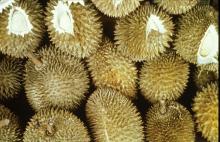Product Description
Maturity and Quality
The fruit is a large (1.5 to 2.5 kg), spiny capsule that opens into five segments containing seeds covered with a pulpy, edible aril. External color changes with maturation from dull olive-green to light yellowish-green. When mature, the fruit drops to the ground, but it can be carefully harvested before this occurs and ripened in 4 to 6 days. Ease of fruit abscission can be used as a maturity index. Fruit is picked with peduncle attached.
- Fruit size (weight), shape, color, freedom from defects and decay
- Internal quality: good color and flavor, fine texture, no wet core or browning
- The overall smell of the ripe durian has three distinct aromas: one strong and onion like, one delicate and fruity, and one offensive smell (due to hydrogen sulfide and diethyldisulfide)
Postharvest Handling and Storage
13-15°C (55-59°F)
Storage potential is 3-5 weeks (mature unripe durians) or 7-14 days (ripe durians).
Vary by cultivar and ripeness stage from 6 to 60 ml CO2/kg·hr at 13°C (55°F) and from 100 to 250 ml CO2/kg·hr at 25°C (77°F); climacteric respiratory pattern.
To calculate heat production multiply ml CO2/kg·hr by 440 to get Btu/ton/day or by 122 to get kcal/metric ton/day.
Ethylene (100ppm) treatment can accelerate ripening and dehiscence of mature but unripe durians and ethylene scrubbing can delay their ripening.
90-95%
Vary from 1 to 7 µl/kg·hr at 13°C (55°F) and from 6 to 35 µl/kg·hr at 25°C (77°F), depending on cultivar and ripeness stage.
An atmosphere of 3-5% O2 and 5-15% CO2 reduces respiration and ethylene production rates, retards ripening, and extends postharvest-life of durians to 8 weeks (vs. 5 weeks in air) at 14°C (58°F).
Disorders
Chilling Injury. Symptoms include black discoloration of durian surface (especially the groove between thorns) and failure to ripen as indicated by loss of ability to convert starch to sugars. Cultivars vary in their chilling sensitivity but all are damaged by storage at 5°C (41°F) for one week or 10°C (50°F) for two weeks.
Uneven Fruit Ripening. A portion of the aril remains hard, leathery, whitish in color, odorless, and tasteless. Larger fruits may have a higher incidence of this disorder than smaller fruits. Incidence and severity are related to preharvest factors that have not been identified yet.
Wet Core (Water Core). Flesh areas appear water-soaked and deteriorate faster than unaffected areas. It is caused by rain just before harvesting.
Fruit rot may be caused by Phytophthora palmivora. Symptoms first appear as small water-soaked lesions on the outer skin which coalesce to form dark-brown lesions followed by the appearance of white powdery masses of sporangia. Control strategies include application of fungicides about one month before harvest, minimizing physical injuries during harvesting and handling, and using good sanitation and temperature management procedures.
References
References from scientifically validated sources will be added in the future.




